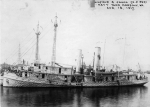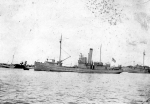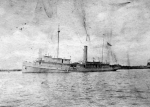Click on thumbnail
for full size image |
Size |
Image Description |
Source |
 |
344k |
At the Norfolk Navy Yard, Virginia on 18 August 1917. Her camouflage appears to be a form of the Mackay Low Visibility type. A similar ship is immediately behind her, also painted in this camouflage scheme
Naval History and Heritage Command photo NH 75515 |
Robert Hurst |
 |
119k |
USS Anderton (SP 530) off Lorient, France, circa 1918. She has the numeral "4" painted on her bow. Ships partially visible in the background are USS Piqua (SP-130), at left, and Cahill at right, with numeral "2" on her bow
Donation of Dr. Mark Kulikowski, 2011
Naval History and Heritage Command photo NH 107339 |
 |
514k |
Off Lorient, France, circa 1918. She has the numeral "2" painted on her bow
Donation of Dr. Mark Kulikowski, 2011
Naval History and Heritage Command photo NH 107338 |
 |
233k |
Lorient, France. View taken on 4 July 1918, showing U.S. Navy minesweepers in the right center, alongside the dock at Base 19. The French Navy machinist school is at left. The inboard ship is a hulk, presumably an old French warship employed as a harbor support vessel. Minesweepers tied up outboard of it include (from left to right): Cahill, USS Douglas (SP-313),
USS Hinton (SP-485), USS Courtney (SP-375), and USS McNeal (SP-333). These former fishing vessels were originally known by their civilian names, respectively: Winfield S. Cahill, Otis W. Douglas, John B. Hinton, Warren J. Courtney and Kenneth L. McNeal. Though ordered shortened to surnames by a July 1917 Navy General Order, the longer names were often used afterwards
Naval History and Heritage Command photo NH 45084 |



